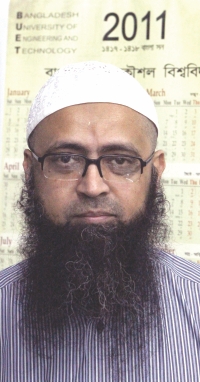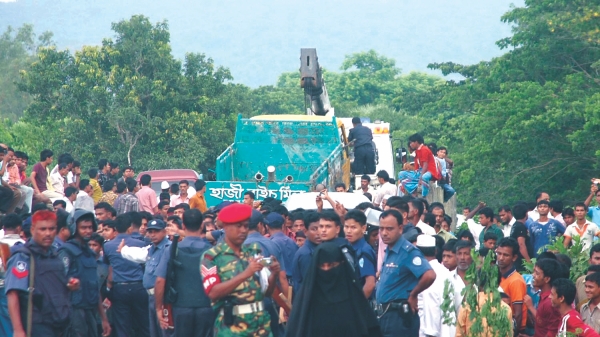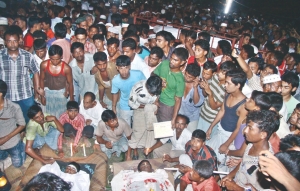| Home - Back Issues - The Team - Contact Us |
 |
| Volume 10 |Issue 28 | July 22, 2011 | |
|
|
Interview ‘The real picture is worse than what is reported’
Dr Hasib Mohammed Ahsan, professor of the Department of Civil Engineering and also director of Accident Research Institute at BUET, is an eminent transport expert of the country. Following the tragic accident at Mirsharai in Chittagong that killed 40 children, Dr Ahsan talks with The Star about the reasons and possible solutions of road accidents. Rifat Munim Based on recent reports in newspapers, we can say that accidents are increasing at an alarming rate claiming more and more lives. The most recent incident at Mirsharai in Chittagong was perhaps the most shocking crash the country has seen in years. As a transport expert, what do you think are the reasons behind this? As we've always said, there are three basic components that cause road accidents. Firstly, the important factor is road environment; secondly, condition of the vehicle and finally the driver's eligibility. The designing and engineering of a road or highway plays the most pivotal role. Apart from engineering, the design must include a road shoulder or sidewalk so that pedestrians can walk along the road without stepping on it. Unfortunately, most of the footpaths in the cities are occupied by make-shift shops, construction materials. Sometimes they are used by motorcyclists. That's why many pedestrians are compelled to step on the road and are run over by buses and cars. If all the footpaths in the big cities especially in Dhaka are cleaned, we can assure you that accidents will reduce significantly. According to available data, pedestrians are the most vulnerable group in cities whereas passengers are vulnerable on highway. Besides, road marking and traffic signs are also important factors in designing. Outside Dhaka, we have often noticed displaced signs and markings. Sight distance, meaning how far and clearly a driver can see in front of him, is another factor. While driving, if something like a sudden turn or big tree stands in the way of his sight in the distance, accidents may happen. Then comes the fitness of the vehicle. There are certain things that ascertain the fitness of a vehicle. In most cases, we have seen that buses or trucks are often modified flouting rules, may be the body will be unduly lengthened or broadened to carry more passengers or goods. Such irregularities make the vehicle unstable which may cause overturning. There are also many regulations regarding overloading or the kind of thing a vehicle can carry. For one thing, trucks cannot carry people, etc. Lastly, the driver must be eligible to perform the job. All these factors together or separately may contribute to a road accident.
What do you think were the determining factors in the Mirsharai accident? Reporters have found fault with the driver's license and defective piling in the sidewalks. We haven't been able to visit the site yet. Still, studying the reports it can fairly be inferred that all three factors have contributed to the disaster. A sidewalk or road shoulder should be divided into a hard shoulder and soft shoulder. The hard one is to support the vehicle in case it skids or slides off the road, and the soft one is for the pedestrians. Then there should be an embankment slope. The person driving the truck was a helper and had a fake license. As we've heard, the truck skidded off the road while making place for another vehicle just before getting on a bridge. If this observation is true, then it was caused by the driver's inexperience. Above all, a truck is not supposed to carry people, leave alone so many children. In addition, the way the truck overturned gives me the idea that it was unfit. So it seems that all the three factors were responsible for that accident. What are the obstacles to putting an end to such dire accidents?
In fact, such large-scale accidents are the consequence of a carefree state in which we fail to realise how gruesome the real picture of road crashes is. Accidents are taking place everyday claiming more and more lives in some parts of the country. The question is how much of those are reported. Only when scores of people die in a crash we see it in the spotlight. Of course the Mirsharai incident should get all the focus. But beyond such big ones, small accidents are rampant throughout the country killing a small number of people regularly. Such small ones often go unreported. According to a statistics, 54 percent of the total deceased in road accidents are pedestrians, on highways or within the city. This data shows that pedestrians are most vulnerable, also indicating the excessive frequency of small accidents which take lives in twos or threes. However, in media you'll but get merely a half of these accidents covered. What is worse, the statistics we often rely on is barely a complete one. For statistical data, we have to depend on the police, but unfortunately many in the police forces do not even know how to fill up the ARF (accident record form) form. Filling up this form is not only time consuming, but also requires prior training in some areas. There is another simple form called FIR (first information form). Most police officers just convert the information from FIR to ARF. As a result, when we get these forms to work out a statistics, what we see is sheer under-reporting that makes us believe that at least half of the accidents or the deceased are left out from the statistics or newspaper reporting. The reason I'm elaborating on this is to stress that the real picture is much worse than what we think but we are not paying proper attention to it at all which is why such large-scale accident took place. What are the initiatives that you think should be taken immediately to reduce road crashes? There are three e's involved in the process of checking road crashes altogether. They are engineering, education and enforcement. In other words, we have to make sure that the roads are properly constructed, the vehicles are fit and the drivers are eligible enough. There are several government agencies to look after this. They have to come forward to monitor and supervise all these things. We know that our demand is higher than supply. Still, we have to mete out punishment to the perpetrators, be that a large-scale or small accident. Otherwise, the sense of impunity will be spread insidiously causing more and more accidents. I'd also say that an owner of a bus should also be held responsible if he is found to have allowed an unlicensed person to drive. The contractors or the concerned company that construct a road must face the music if any fault with the road construction is found. As for education, There can be formal education for drivers in the form of training. Massive awareness programmes through media can be launched to make pedestrians and passengers aware of their responsibilities. We all have a tendency to flout travelling rules on roads; the rickshaw-puller takes the wrong road, so do the car and bus drivers. Through a mass awareness programme, may be we can instil a sense of responsibility in all. Finally, I believe that if all these understandings are limited to experts and a little section of the people, no change will take place. The policymakers should take the initiative. If they realise that road crash is a social disease which must be addressed immediately, I'm sure enforcement of all the laws and regulations can be ensured much easily and more effectively.
Copyright
(R) thedailystar.net 2011 |


